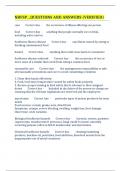Summary
Full summary Politics and Development
- Course
- Institution
This is a comprehensive summary of both the slides and class notes from professor Iniesta's Politics of Development course. In this summary, you'll find all the key pictures, graphs, and maps used in class, making the material easier and more enjoyable to learn. Additionally, it includes detailed c...
[Show more]












